An imaginative, James Corner Field Operations-led revamp of a Brooklyn playground, an SOM-designed lab facility in Harlem, and the expansive restoration of a historic outer-borough Carnegie Library building are among the winning projects of the New York City Public Design Commission (PDC)’s 39th Annual Awards for Excellence in Design.
As evidenced by the three winning projects mentioned above, the just-announced awardees are, as in years past, a diverse bunch although parks and playgrounds, both newly constructed and reimagined, dominated the list this year. That was intentional on the part of the PDC given the essential function of city parks over the past year-plus. While the Department of Parks & Recreation-operated green spaces have long played a vital role in the complex and layered urban fabric of New York City, that role only became more consequential during the pandemic.
“Over the past year, it has become abundantly clear that well-designed and sustainable public parks and open spaces are essential foundations of public health. This year’s awards will focus on projects and programs that will provide and maintain these critical places for social gathering, recreation, and wellbeing,” said Signe Nielsen, a Manhattan-based landscape architect and president of the 11-member Public Design Commission.
Alongside Nielsen, the winning projects were announced by Deputy Mayor for Housing & Economic Development Vicki Been and Keri Butler, a 15-year veteran of the PDC who was appointed by Mayor Bill de Blasio as executive director this past April following the departure of Justin Garrett Moore.
“These award-winning designs reflect our City’s commitment to recovery and long-term resiliency, providing critical public spaces that enhance our physical and mental health and enrich our cultural and civic lives,” added Butler.
While all five boroughs (and Westchester County) are represented amongst the dozen Excellence in Design Award-winning projects, Brooklyn leads the pack with five projects in neighborhoods including Red Hook, Brownsville, and Greenpoint. Manhattan is home to two winning projects while the Bronx, Queens, and Staten Island can each claim one. One project is a city-wide initiative and the other, as mentioned, is a Department of Environmental Protection-operated facility located just north of the city in Westchester County.
In addition to the winning individual projects, the PDC announced two Special Recognition Awards: one goes to a generous handful of different initiatives collectively working to protect New York City’s vulnerable waterfront communities through coastal resiliency projects. The other is bestowed to the maintenance, operations, and art conservation teams of the various park conservancies, nonprofits, and operators who tended to the city’s open spaces during an extended period of historic duress.
Below are the 12 recipients—with project descriptions and imagery courtesy the PDC along with the names of the spearheading city agencies and outside firms, artists, and collaborators—of this year’s Awards For Excellence in Design along with the (multitude of) Special Recognition Award honorees. More detailed descriptions of the winning projects can be found in the 39th Annual Awards for Excellence in Design book.
Reconstruction of Grant Park | The Bronx

- A project of the Department of Parks & Recreation and the Department of Transportation
- Stantec
- “As part of the Jerome Avenue rezoning initiative, this project will convert a portion of the Grant Avenue roadbed into green space, integrating two smaller areas into one larger and more cohesive park. Designed to serve a growing community, the enlarged park will feature natural lawn for passive recreation and field games, shaded areas for seating and gathering, and an active recreational zone with a full-size basketball court and adult fitness area.”
Reconstruction of soccer fields at the Red Hook Recreation Area (Phase IV) | Brooklyn
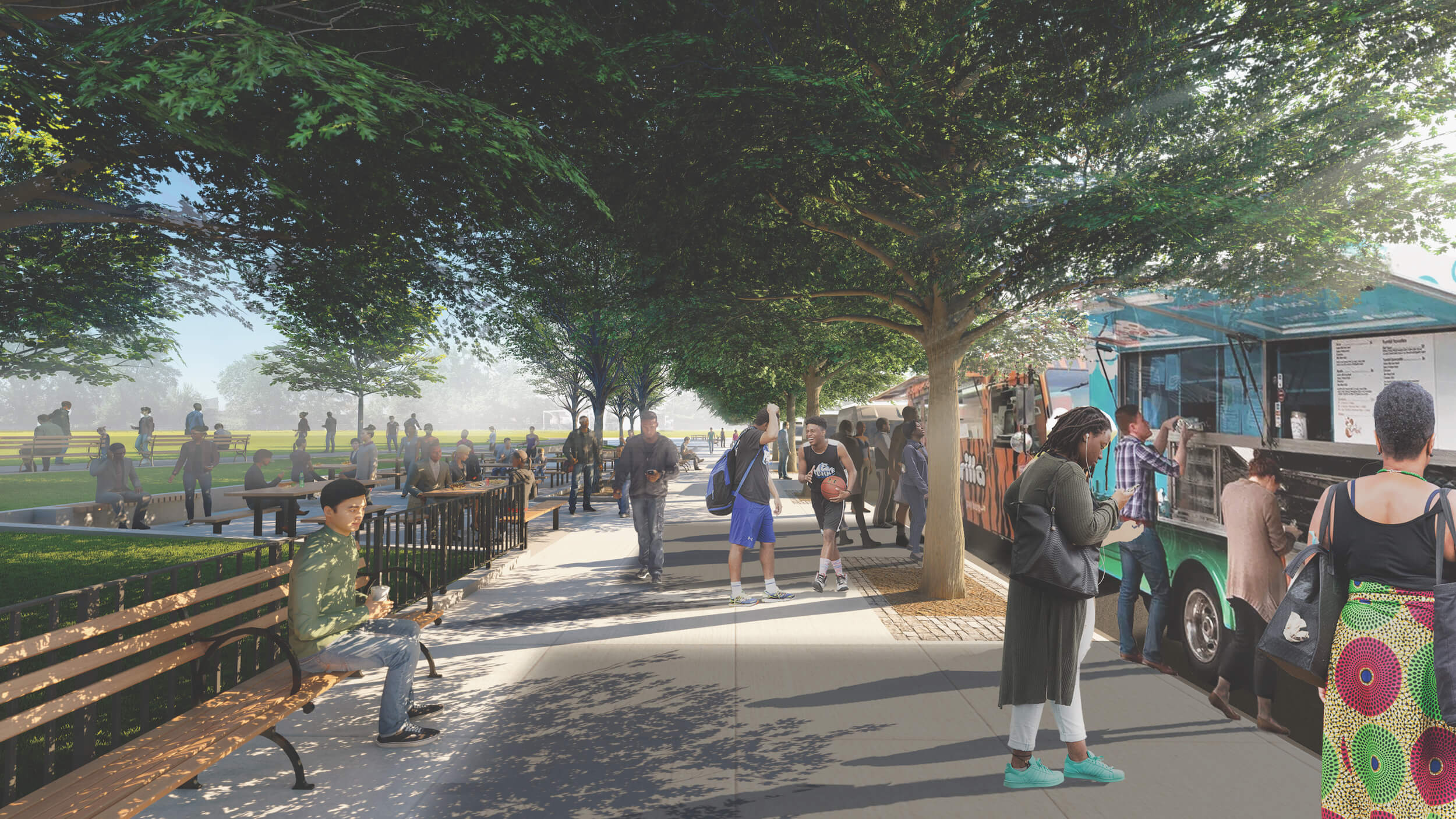
- A project of the Department of Parks & Recreation
- Abel Bainnson Butz
- “As the final phase of the 36-acre reconstruction of the Red Hook Recreational Area, this project will complete the transformation of a formerly contaminated industrial site and popular neighborhood park into a city-wide destination for multi-generational recreation. The design includes storm resiliency and sustainability interventions, park-wide circulation and accessibility enhancements, and a gathering space with a variety of seating to accommodate the Food Truck Marketplace held along Bay Street.”
Construction of Bushwick Inlet Park, Motiva Parcel | Brooklyn
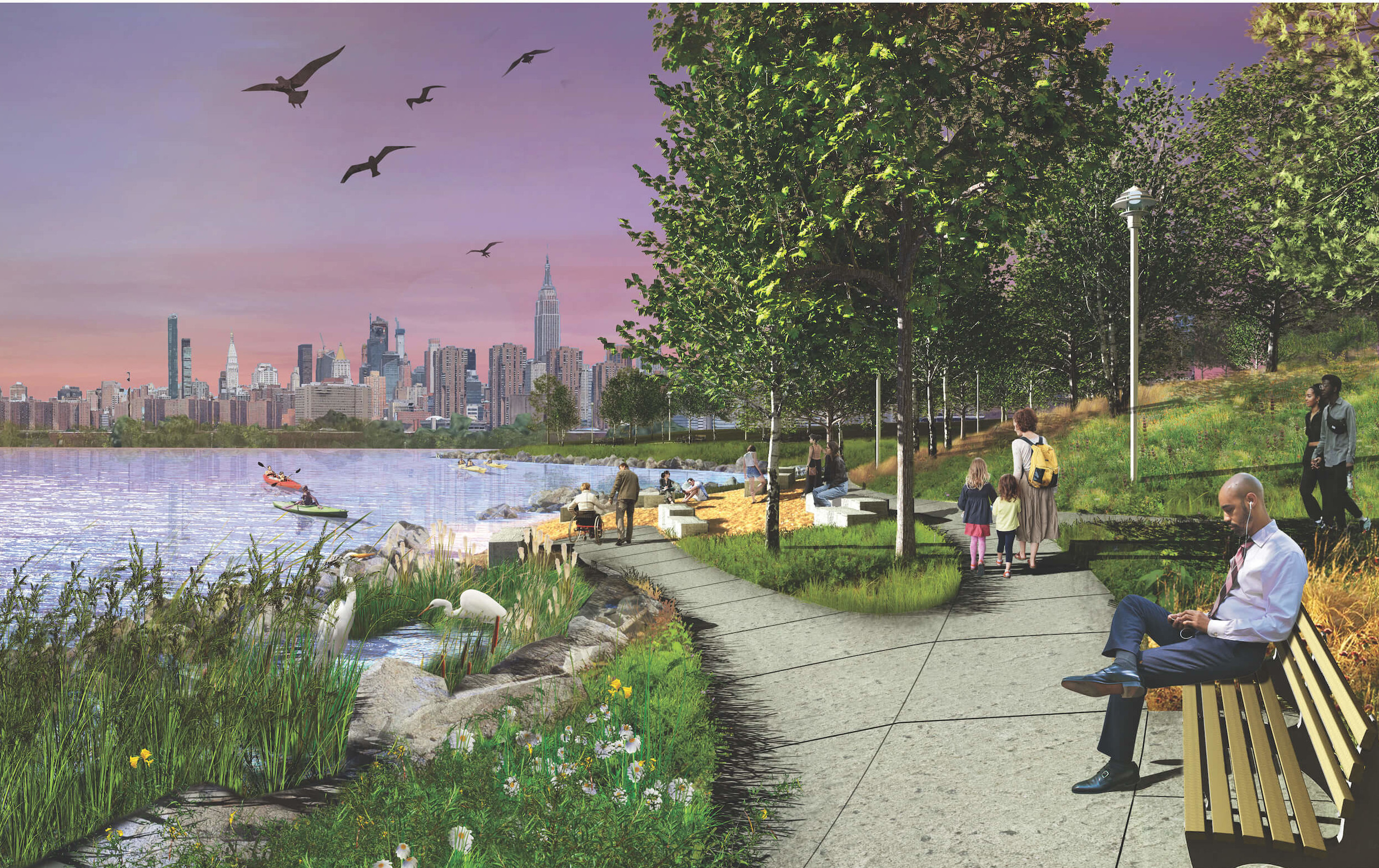
- A project of the Department of Parks & Recreation
- Abel Bainnson Butz
- “A critical component of a larger waterfront park initiative and in line with the Williamsburg-Greenpoint Master Plan, this project will remediate a post-industrial landscape while restoring the local ecosystem. A continuous accessible esplanade includes areas for passive recreation such as nature observation points, and a kayak launch provides access to the water for more active pursuits.”
Reconstruction of the Pool and Rink at the Harlem Meer | Manhattan
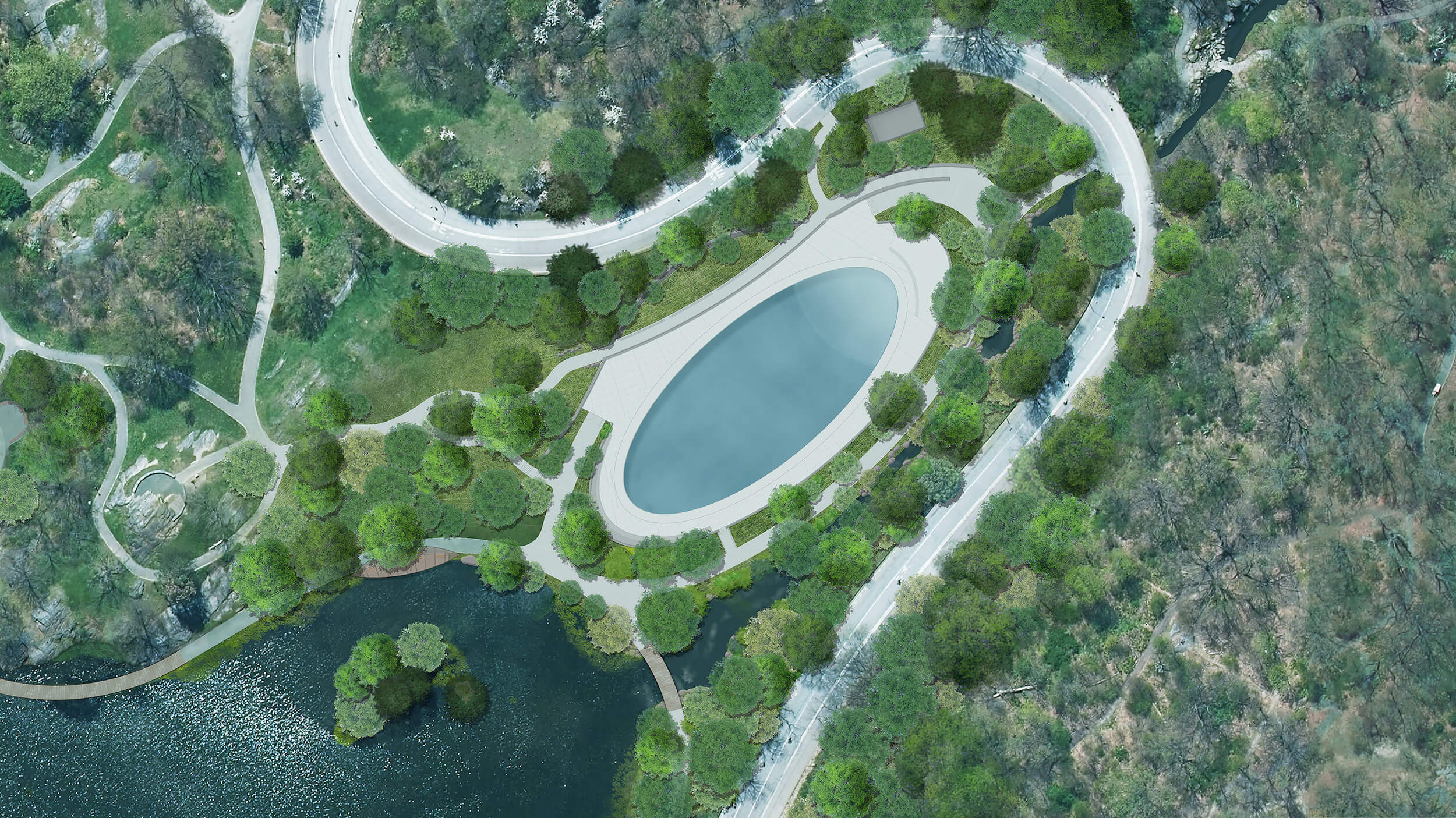
- A project of the Department of Parks and Recreation and the Central Park Conservancy
- Susan T. Rodriguez Architecture & Design; Mitchell-Giurgola
- “The capstone effort of a decades-long commitment to restore the northern end of the Park as a vital resource for the surrounding community, this new pool and rink will replace a failing facility with one inspired by the visionary design of the landmarked park and the tradition of fusing architecture and landscape. Integrated into the topography of the site, the structure’s mass will be minimized while providing open and light-filled spaces. The oval-shaped pool, which will be transformed into a flexible recreation space in spring and fall and an ice-skating rink in winter, is framed by a low retaining wall enveloped by a landscape berm. A stream course and park path that were displaced by the construction of the existing facility will be re-established, restoring the continuity of the landscape. The Meer shoreline adjacent to the facility will be naturalized, and a waterside pergola and boardwalk through freshwater marsh plantings will support nature-based recreation.”
Reconstruction of Gorman Playground | Queens

- A project of the Department of Parks and Recreation
- Department of Parks and Recreation in-house
- “Exemplifying a commitment to inclusive play and universal design, this park reconstruction will offer play opportunities for a wide range of ages and abilities. The play structures feature multiple accessible ramps as well as a variety of slides and climbers. Cozy spaces off the main play area provide a more intimate play experience with lower sensory stimulation. The spray shower, which doubles as a seating area and free play space during cooler months, has both decorative sea animals and ground sprays. Companion seating can be found throughout the play area, bordered by new plantings chosen for their seasonal and sensory interest. Great care was taken to locate new playground features around existing trees and to increase surface permeability for better stormwater retention.”
Reconstruction of Dongan Playground | Staten Island

- A project of the Department of Parks and Recreation
- Department of Parks and Recreation in-house
- “Utilizing adaptive strategies for building in the floodplain while maintaining typical park functions, this design accommodates sea level rise for the lifespan of the playground. High-value structures are elevated above the projected floodplain and water from moderate storm events is detained below the raised park, decreasing surface flooding and lessening the burden on the neighborhood stormwater system. A large play area with ample seating welcomes students and parents into the park after school. A central ramp connects to elevated play equipment, raising accessible play experiences, while containing the active play zone. The tot-lot and game tables are separated into the quieter spaces within the park, while the synthetic turf lawn creates opportunities for unprogrammed and intergenerational play.”
Reconstruction of Ericsson Playground | Brooklyn
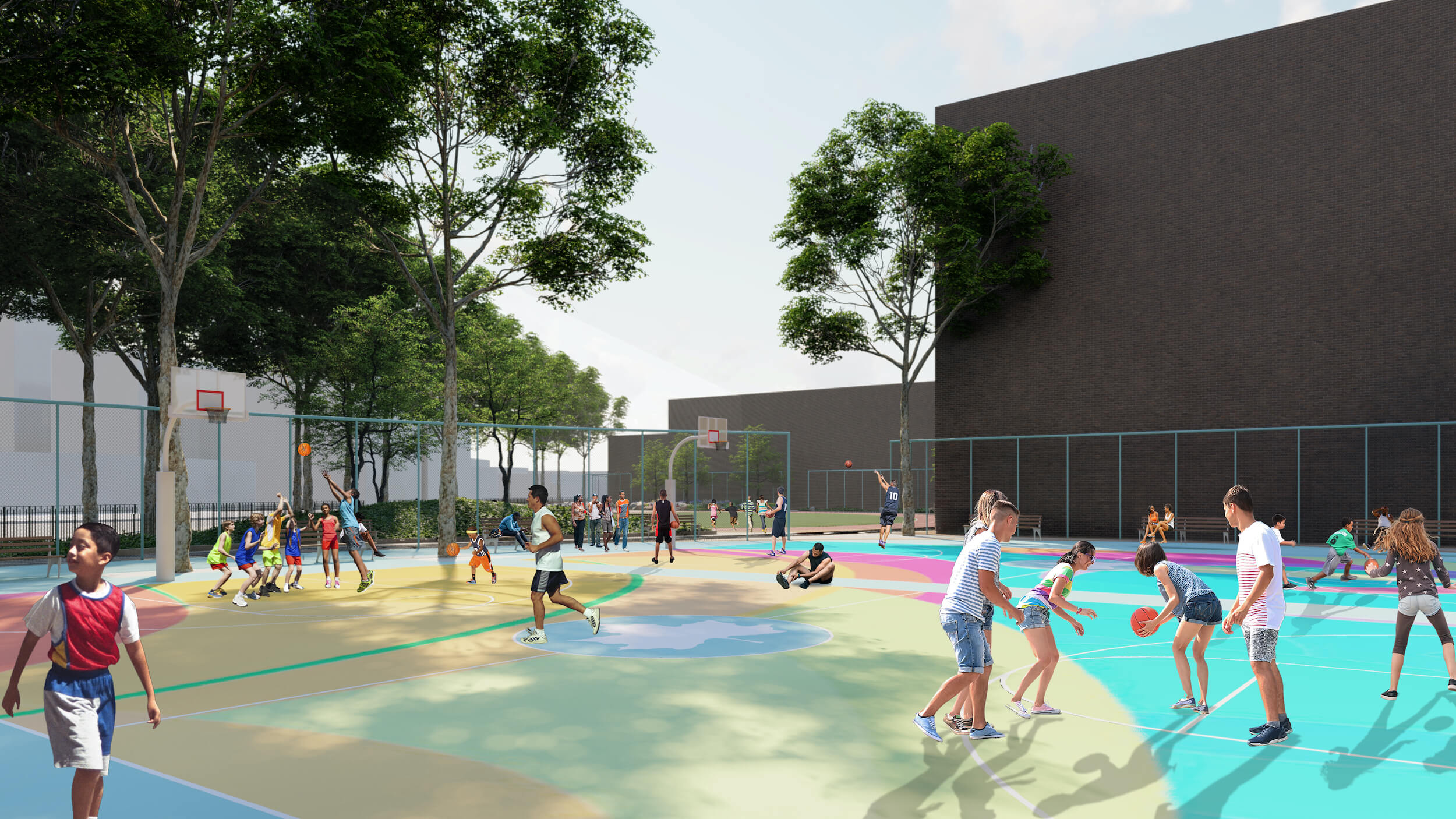
- A project of the Department of Parks & Recreation
- James Corner Field Operations
- “Designed in part to serve the Magnet School for Environmental Engineering, this park will nearly triple the amount of planting on site and expand on the school’s eco-focused mission and programs. A nature trail defines three activity areas: a flexible field and running track, basketball courts with an outdoor fitness area, and a unique climbing feature called the “Tree House” that is universally accessible and promotes rigor, challenge, and socialization.”
Modular comfort station prototype for parks citywide
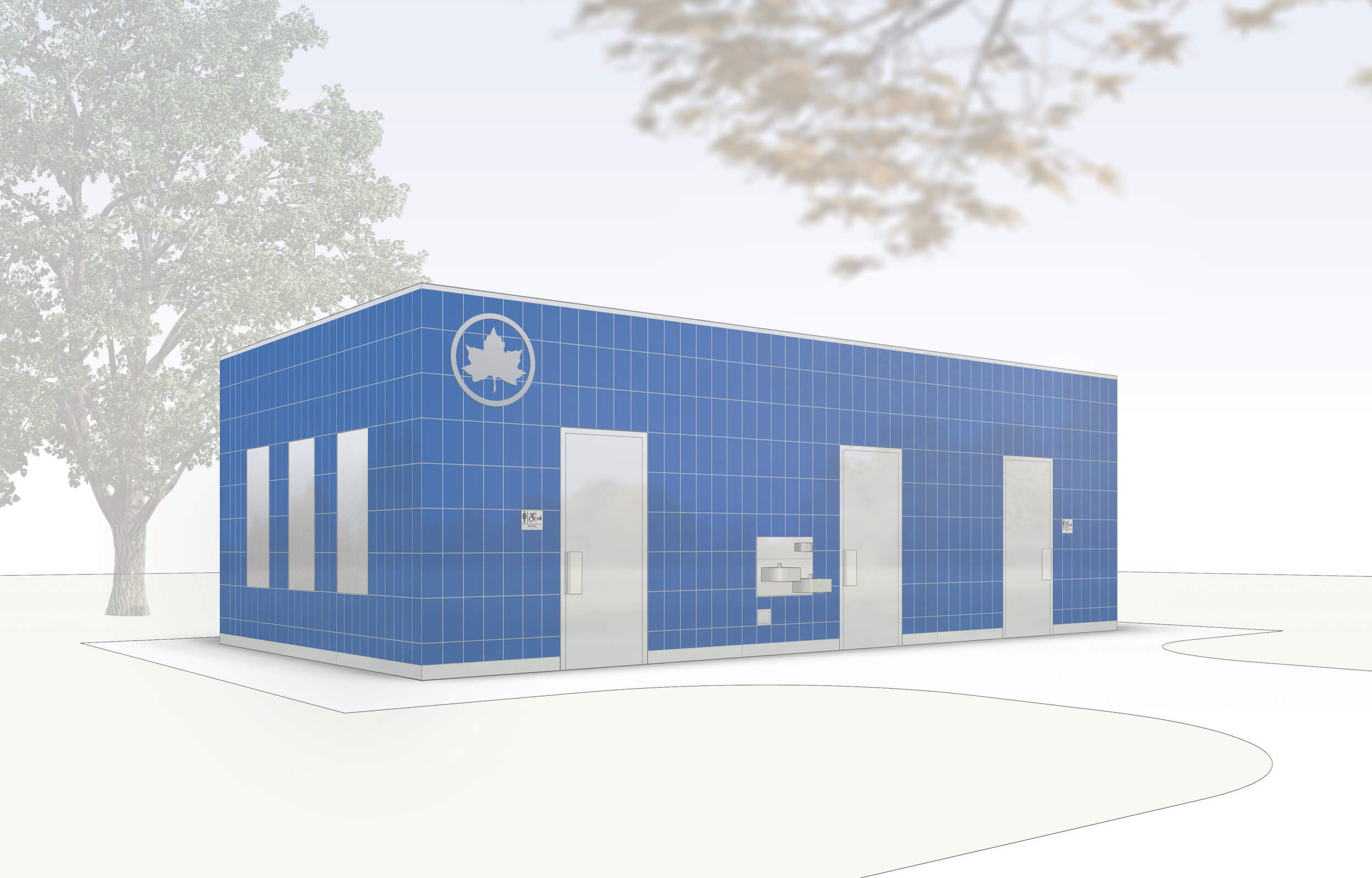
- A project of the Department of Parks & Recreation
- 1100 Architect
- “Piloted in Staten Island’s Luis Lopez Playground, this comfort station prototype utilizes the efficiencies of off-site construction and the lower costs associated with modular production techniques to economically provide amenities in the City’s public spaces. The steel-frame structure is clad with a pattern of glazed blocks in a variety of color options, depending on the site, while a green roof enhances the project’s environmental performance. The station includes two restrooms and a space for park maintenance, and is designed to be universally accessible, vandal resistant, and available year-round.”
Brownsville Library renovation and expansion | Brooklyn
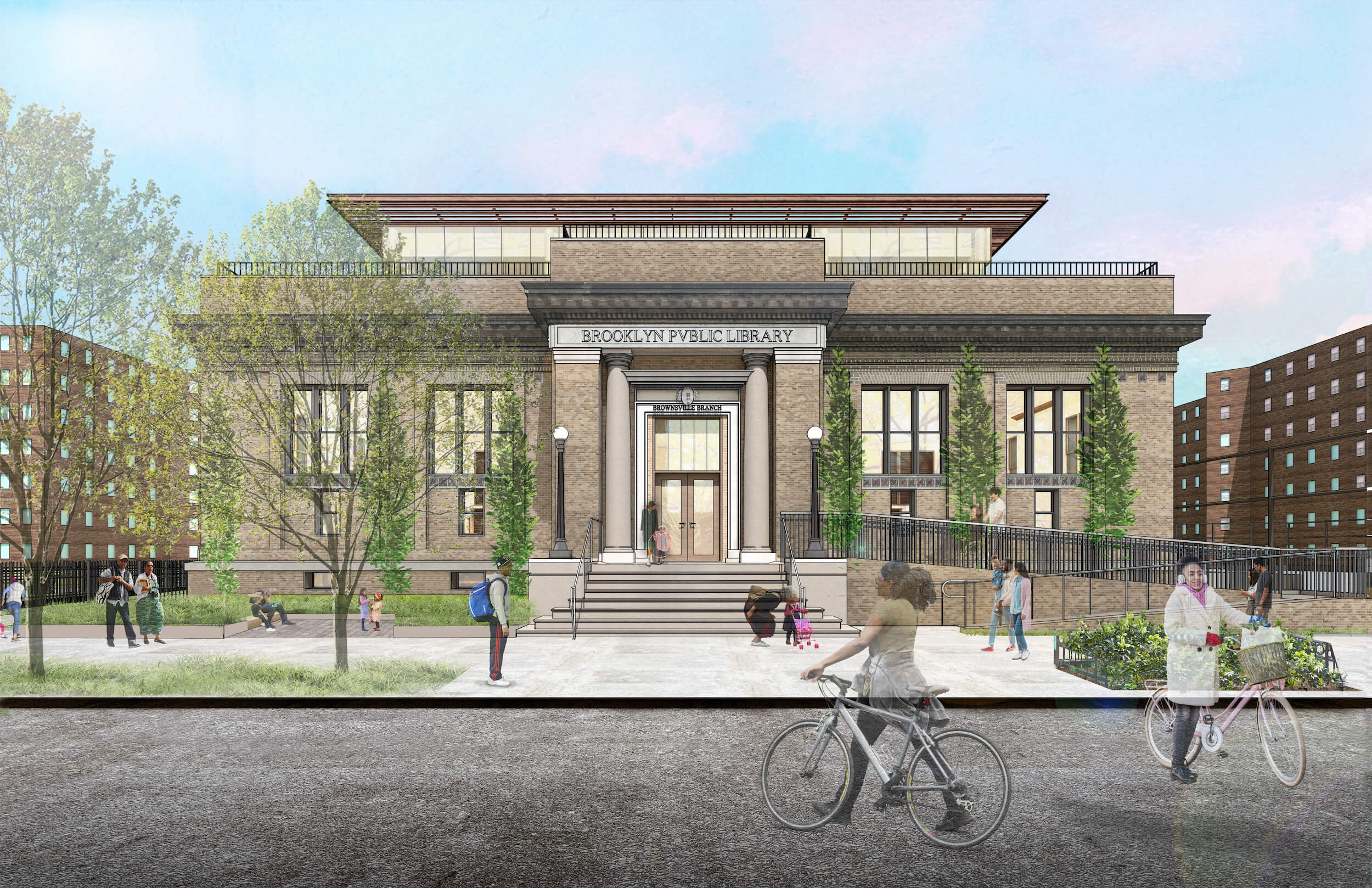
- A project of the Department of Design and Construction and Brooklyn Public Library
- LTL Architects, Architectural Preservation Studio, Local Office Landscape + Urban Design
- “The restoration of this historic Carnegie library will provide inspirational light-filled spaces while the addition will enhance the facility’s ability to provide 21st-Century services to the Brownsville neighborhood. Given the multi-faceted social and cultural roles performed by branch libraries today, this project is designed as a center of hope, learning, and gathering for a community that has been disproportionally impacted by the Covid-19 pandemic.”
Paradise Parados by Teresita Fernández | Brooklyn

- A project of the Department of Cultural Affairs and the Brooklyn Academy of Music
- Teresita Fernández, Camber Studios
- “Fabricated from mirror-polished stainless steel, this site-specific installation will reflect the changing light of the day and seasons, passersby, street activity, and the surrounding tree canopies of the sculpture’s dynamic urban surroundings. Derived from the meandering ivy-covered brick walls common throughout Brooklyn’s urban landscape, the artwork’s form becomes a canopy that suggests a draped, proscenium-like entrance, mimicking the undulating curtains that would frame a stage.”
Public Health Laboratory at the Harlem Hospital Center | Manhattan
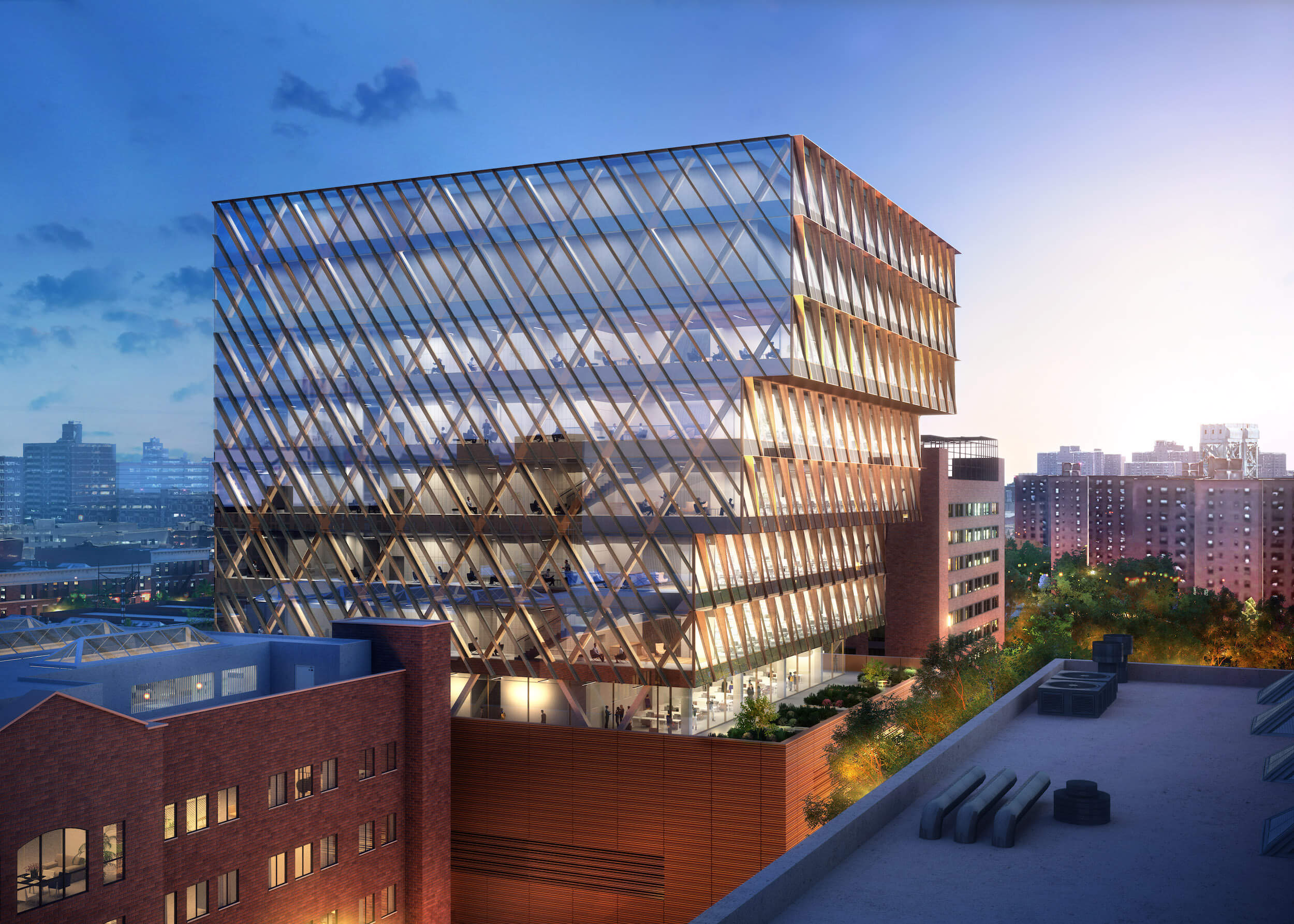
- A project of the Economic Development Corporation and the Department of Health and Mental Hygiene
- Skidmore, Owings & Merrill
- “The New York City Public Health Laboratory’s new 230,000 square foot building will further strengthen the City’s capability to protect and promote the health of all New Yorkers. Located adjacent to Harlem Hospital, the state-of-the-art lab will allow for testing and services for a wide range of clinical and environmental health-related concerns. From microbiology and virology, to immunology and biosafety, the new laboratory will enhance the City’s response to emerging public health challenges like COVID-19. The building’s design is characterized by its structural diagrid and corresponding diagonal glass and metal cladding. On the south side, the volume steps to accommodate various laboratory sizes – resulting in a massing that provides passive solar shading. The building will comply with the City’s ambitious resiliency and sustainability regulations.”
Waterfowl Management Program Building | Kensico Reservoir, Valhalla
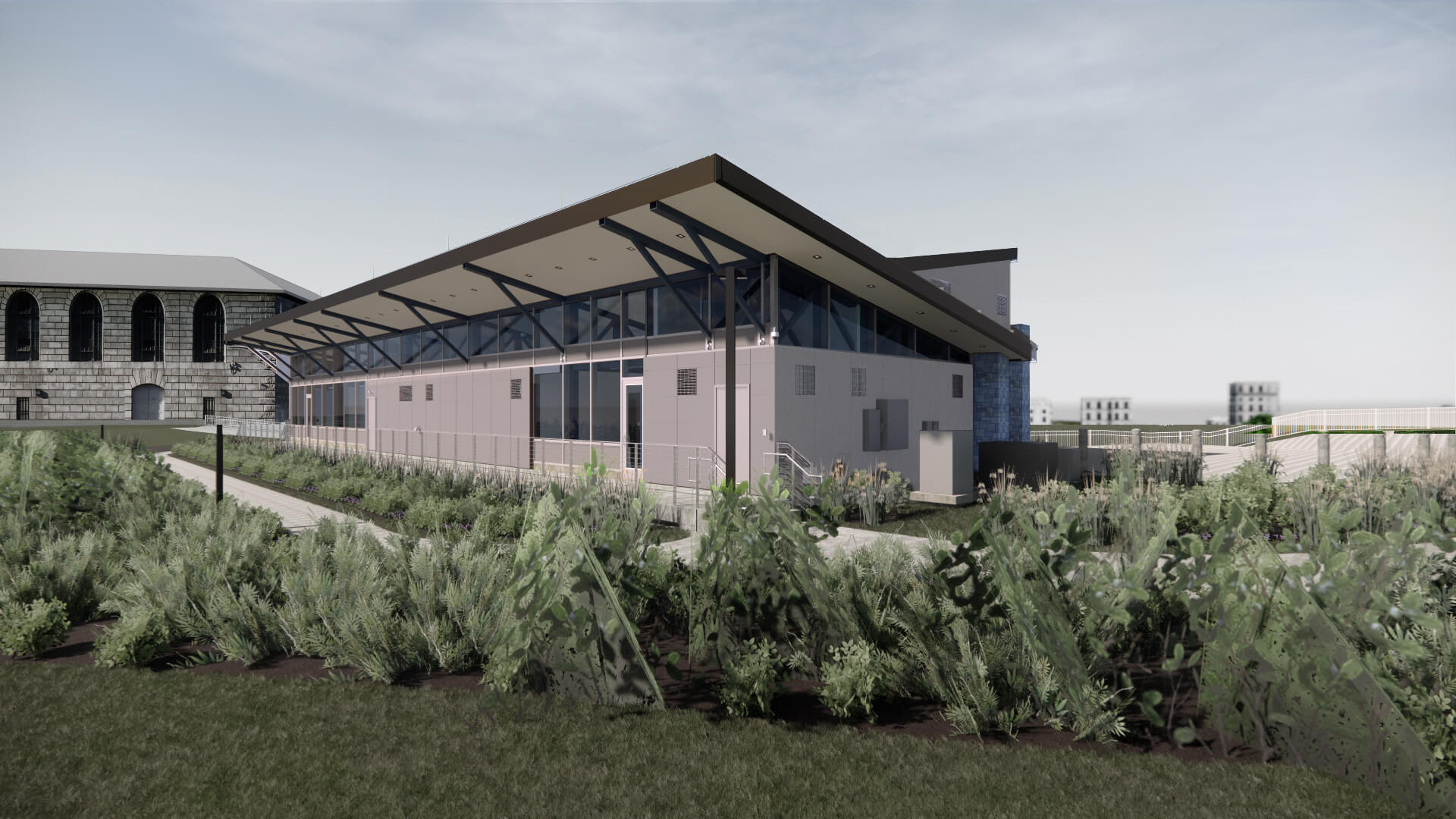
- A project of the Department of Environmental Protection
- Hazen and Sawyer, Goshow Architects
- “Sited on the shoreline of the Kensico Reservoir, the Waterfowl Management Program building will provide the resources necessary to maintain the safety and high quality of NYC’s drinking water. The new facility will enhance the program with offices, storage, and training spaces, as well as boat repair and maintenance workshop. Expansive glazing provides unrestricted views to observe the water and surrounding site, while the rear façades face the reservoir’s historic campus and are primarily clad in stone, providing an aesthetic continuity with the nearby early 20th-century buildings.”
Special Recognition Awards
Citywide Coastal Resiliency Initiatives
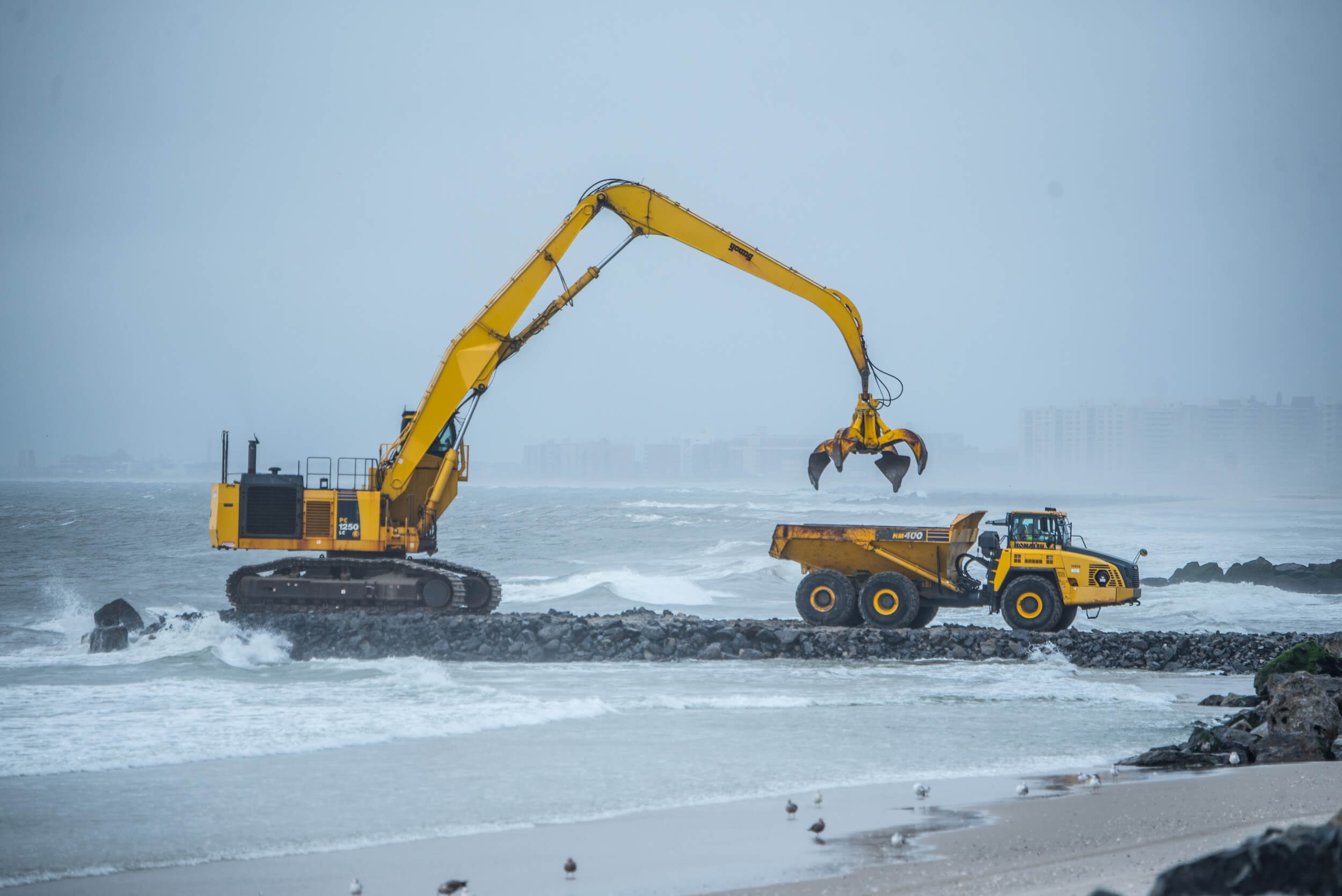
They include: including the Raise Shoreline program, the US Army Corps Staten Island Coastal Storm Risk Management and Rockaways Atlantic Shorefront Projects, East Side Coastal Resiliency, Lower Manhattan Coastal Resiliency, and Interim Flood Protection Measures by the Mayor’s Office of Climate Resiliency, New York City Economic Development Corporation, Department of Design and Construction, Department of Environmental Protection, Department of Parks and Recreation, Department of Transportation, New York City Emergency Management, and the US Army Corps of Engineers.
- “New York City is advancing the largest and most ambitious portfolio of coastal resiliency projects anywhere in the United States. These projects, which are being implemented across all five boroughs, use a wide variety of design features to protect against coastal storms, prevent regular tidal flooding caused by rising sea levels, reduce beach erosion, and guard critical infrastructure like the Hunts Point Food Markets. As the impacts of the climate crisis continue to worsen, cities around the world are reimagining how their waterfront areas can evolve to meet the needs and challenges of the 21st century.”
Parks Maintenance, Operations, and Art Conservation Staff
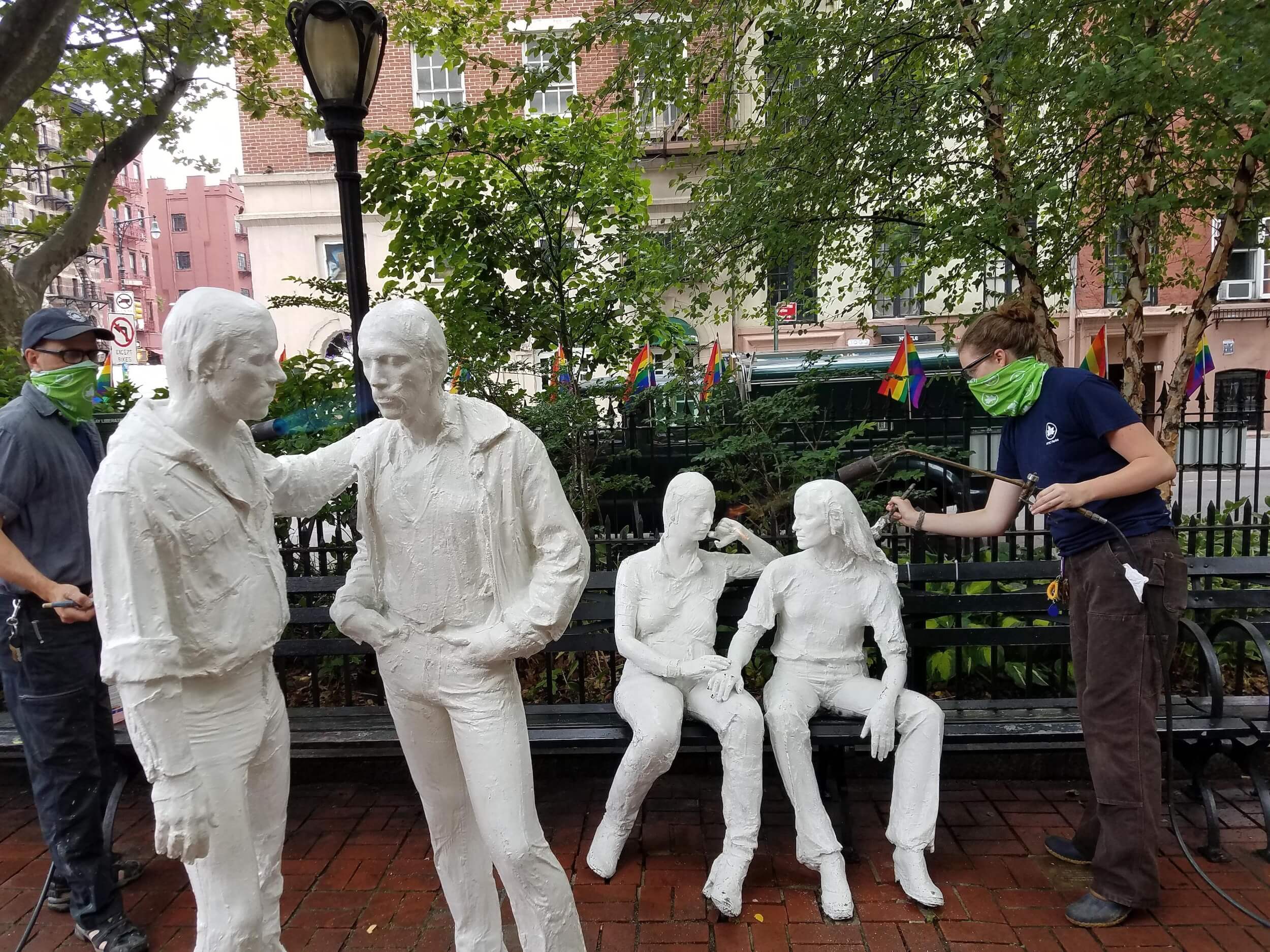
They include: Department of Parks & Recreation, Asphalt Green, Bronx River Alliance, Bryant Park Corporation / 34th Street Partnership, Central Park Conservancy, City Parks Foundation, Alliance for Flushing Meadows Corona Park, Forest Park Trust, Friends of the High Line, Greenbelt Conservancy, Historic House Trust, Hudson Yards Hell’s Kitchen Alliance, Lincoln Center for the Performing Arts, Lower East Side Ecology Center, Madison Square Park Conservancy, New York Restoration Project, Prospect Park Alliance, Randalls Island Park Alliance, Riverside Park Conservancy, The Battery Conservancy, and Times Square Alliance.
- “Throughout the pandemic, New Yorkers have recognized the importance of neighborhood parks for providing access to recreation, safe gathering spaces, and enhancing health and well-being. This award celebrates the citywide staff whose dedication and efforts have ensured that these spaces are clean and safe for the public to enjoy every day.”











